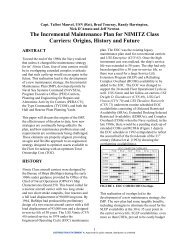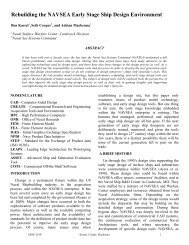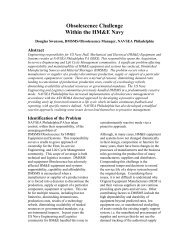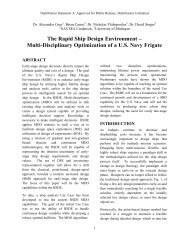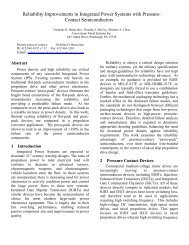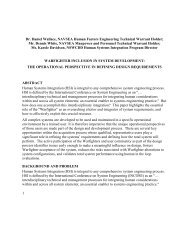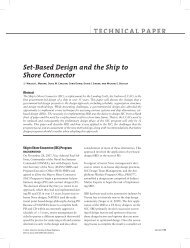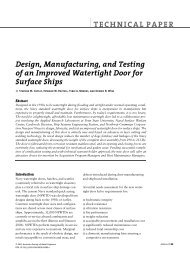The Wreck of DKM Bismarck − A Marine Forensics Analysis 1 The ...
The Wreck of DKM Bismarck − A Marine Forensics Analysis 1 The ...
The Wreck of DKM Bismarck − A Marine Forensics Analysis 1 The ...
You also want an ePaper? Increase the reach of your titles
YUMPU automatically turns print PDFs into web optimized ePapers that Google loves.
<strong>The</strong> <strong>Wreck</strong> <strong>of</strong> <strong>DKM</strong> <strong>Bismarck</strong> <strong>−</strong> A <strong>Marine</strong> <strong>Forensics</strong> <strong>Analysis</strong><br />
Although bottom sediments prevented a survey <strong>of</strong> the forward 25% <strong>of</strong> the hull below<br />
Batteriedeck level, it has been estimated from the damage survey done in May 2002 that<br />
approximately 30% <strong>of</strong> the lower hull is completely missing as a result <strong>of</strong> this hydraulic outburst.<br />
<strong>The</strong> lower decks <strong>of</strong> the ship, beneath the armor deck, have been compressed vertically by 3-4<br />
meters. Most <strong>of</strong> the missing hull components remain at or near the impact point, 1000 meters upslope<br />
from the main wreck. In a few areas, the lower hull has remained attached to the ship's<br />
bottom, and can be seen lying on top <strong>of</strong> the sediment next to the wreck. <strong>The</strong>se lower hull<br />
fragments are bent and twisted, probably from the slide down the slope. This slide has also<br />
shoveled tons <strong>of</strong> bottom sediment into the wreck, like a large scoop. This sediment slopes<br />
downhill inside the wreck, indicating a raised edge just below the sediment, and a cavity inside.<br />
This would be consistent with the shell plating blowing outward down to about the curvature <strong>of</strong><br />
the double-bottom, which would be stronger. <strong>The</strong> combination <strong>of</strong> hydraulic outburst and the<br />
tearing away <strong>of</strong> the shell plating make it difficult to determine where there was torpedo damage.<br />
Forward, the hull has been blown outward and is lying on the bottom sediment. This<br />
seems to be true on both sides from forward <strong>of</strong> the capstans to abeam turret Anton, though on<br />
the starboard side the effect is largely buried by sediments.<strong>The</strong> blown-out hull emerges from<br />
these sediments just abeam <strong>of</strong> turret Anton. <strong>The</strong>re is also evidence <strong>of</strong> buckling in the hull plating<br />
outside <strong>of</strong> turret Bruno. This is further evidence that the bow struck the seamount first.<br />
Where the “blow-out” effect can be seen clearly is on the port side. It is evident that the<br />
upper decks <strong>of</strong> the ship (Batteriedeck and Zwischendeck) have been crushed down with the<br />
spaces under them by at least one deck level, possibly two. This would indicate that powerful<br />
forces have crushed the ship in the foc'sle region. <strong>The</strong> increased intensity <strong>of</strong> the outburst effect<br />
forward is consistent with a bow-first impact.<br />
An ROV inspection <strong>of</strong> the interior <strong>of</strong> the long hole in the hull on the aft starboard side<br />
indicates that the longitudinal bulkhead, which divided the outer trim tank space from the inner<br />
oil tank, has been crushed down in a long, uniform accordion fold, almost like a piece <strong>of</strong> thick<br />
fabric. This would indicate that the Middle and Lower Platforms have been severely crushed.<br />
This tank inner wall was otherwise undamaged, indicating that its condition was not the result <strong>of</strong><br />
the explosion <strong>of</strong> torpedoes or shells. For this wall to be warped, but not affected by explosion<br />
damage over such a long area, and lying just inboard <strong>of</strong> such a long open hole in the outer hull,<br />
clearly shows that the outer hole is the result <strong>of</strong> hydraulic forces and not explosion damage.<br />
An inspection <strong>of</strong> the overhead inside this long "outburst" hole revealed that the underside<br />
<strong>of</strong> the massive plating <strong>of</strong> the armor deck, including its outboard slope, was not damaged and<br />
virtually intact, despite being adjacent to such wholesale destruction <strong>of</strong> the outer portion <strong>of</strong> the<br />
ship. Only 0.5 meters from where the hull had been ripped away for more than 30 meters, the<br />
armor deck appears intact. This again supports the idea <strong>of</strong> uniform fluid pressure creating the<br />
outburst, rather than torpedo or shell explosions. This conclusion seems inescapable.<br />
<strong>The</strong> 2001 ITN expedition that explored the <strong>Bismarck</strong> wreck identified these holes as the<br />
evidence <strong>of</strong> torpedo damage. This supposed "torpedo damage" was as great on the port side as<br />
the starboard, even though most <strong>of</strong> the torpedo hits were claimed to have occurred on the<br />
starboard side. Previous forensic analysts concluded that a number <strong>of</strong> unlikely but possible<br />
claimed hits by the cruiser Norfolk and the battleship Rodney could now be confirmed. <strong>The</strong>se<br />
analysts also concluded, as a consequence, that the scuttling claimed by the German survivors<br />
was unlikely and irrelevant, that the torpedo damage inflicted by the British torpedo hits was<br />
more than enough to have caused the ship to sink when it did 37 .<br />
37 Mearns, David, and White, Rob. Hood and <strong>Bismarck</strong>. London: Channel 4 Books, 2001.<br />
42



